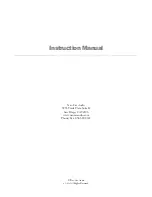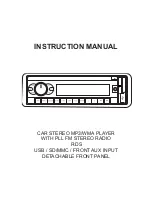
4. Locate the 3/8" Yellow Tubing which is attached
to the elbow on top of the manifold and run the
tubing along its course to the tank and trim to
length. Insert the tubing into the Holding Tank
Shut–Off Valve fitting. Make sure the tubing is
pressed in all the way past the O–ring. The fit-
ting will grab the tubing and seal it in place.
F. Start Up
At time of start up and each time the filters are
changed the system should be sanitized (also see
Operation and Maintenance Sec. V, B.1–4, page
10).
1. Sanitizing the system. Use a drip pan to aid
clean–up.
NOTE:
The system should be sanitized
BEFORE installing the Sediment/Carbon
Prefilter, the Activated Carbon Post Filter or the
R.O. Membrane.
• Use a good quality unscented 5 % liquid
chlorine household bleach.
• Open the Dispensing Faucet by lifting the
black handle and open the Holding Tank
Shut–Off Valve (the handle should be parallel
with the valve body).
• Remove the plug on the underside of the
manifold labelled “SEDIMENT/CARBON”.
Pour one capful of bleach (this is approxi-
mately 2 tsp. or 10 ml) into one of the white
Housings. Insert Housing O–ring into the
Housing groove, (press firmly in place).
Engage and firmly tighten the Housing hand
tight only.
• Remove the plugs labelled “MEMBRANE”
and “ACTIVATED CARBON” from the under-
side of the manifold. To each of the remain-
ing white Housings, add one capful of bleach.
Insert a Housing O–ring, engage and firmly
tighten the Housings hand tight only.
• Slowly open the Feed Water Saddle Valve
(turning counter clockwise).
• As soon as the water begins to come out of
the Dispensing Faucet, close the Faucet.
• Let stand for 15 minutes.
NOTE:
During this time, check the system
carefully for leaks.
• At the end of 15 minutes, CLOSE the Feed
Water Saddle Valve and open the Dispensing
Faucet.
• Allow the Holding Tank to completely drain,
then remove the Sediment/Carbon Filter
Housing (the farthest of the three from the
In–Out ports), empty, and install the
Sediment/Carbon Prefilter. Firmly tighten the
Housing hand tight only.
• Remove the Activated Carbon Filter Housing
(the closest of the three to the
In–Out Ports), empty, and install the
Activated Carbon Post Filter. Firmly tighten
the Housing hand tight only.
2. Installing the R.O. Membrane:
• Remove the R.O. Membrane Housing, (the
middle one), and empty.
• Insert the Membrane up into the manifold.
(The O–rings should be up toward the mani-
fold.) Check the Housing O–ring for proper
position in its groove, engage and firmly tight-
en the Housing hand tight only.
3. Rinsing the system:
• Slowly open the Feed Water Saddle Valve
fully counter clockwise.
• The Holding Tank Valve should be open.
• Check the Air Gap Window on the Dispensing
Faucet to be sure that the drain water is flow-
ing. (Refer to Figure 2, page 6.) The R.O.
System is now making water.
• Do not open the Faucet for at least 6 hours.
• Do not use the first three full tanks of water.
CAUTION:
The R.O. Membrane is shipped
with a preservative in it. This will be rinsed
out with the first water produced. Allow the
Holding Tank to fill (overnight) and discard
the first three full tanks of production. It takes
approximately 6 hours to make a full tank.
When the Faucet is first opened, expect air
and carbon fines (very fine black powder)
from the Activated Carbon Post Filter to be
rinsed out. This is normal for the first tank of
water or after the Activated Carbon Post
Filter is changed.






































